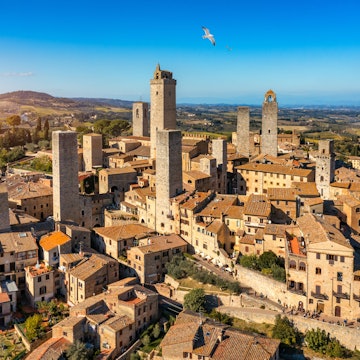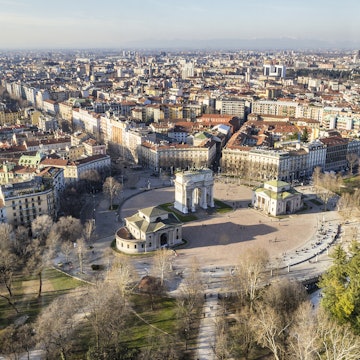

See the best of Italy's Campania with this guide to local experiences. Shutterstock
Campania is Italy in a double espresso shot: hot, feisty, passionate, loud, intense and big-hearted. Whether you’re walking in the footsteps of toga-wearing Romans through ancient ruins, clambering up the volcanic crater of smoldering Mt Vesuvius, or feasting on pizza, Caravaggio and street art in Naples, this could well be the Italy of your wildest dreams. All the drama and decadence of Italian life is crammed into this southern region.
As you helter-skelter along the cinematically beautiful coastal roads of the Amalfi Coast, where cliffs drop to pastel-painted villages and the glittering blue Tyrrhenian Sea, and swim in the azure waters of Capri, you’ll gain a deep understanding of la dolce vita. After all, when life gives Campania lemons, it makes limoncello (lemon liqueur).
Read on for our favorite things to do to get a real flavor of the region.

1. Strike a pose on Capri
Benvenuto (welcome) to the supermodel of the Italian islands. You’ve heard the hype and you can believe it. Off the west coast of the Sorrento Peninsula, Capri is off-the-charts beautiful. With roads rollercoasting down to the bluest-of-blue seas, steep cliffs punching above gold-sand bays, bougainvillea-swathed villas, and yacht harbors as polished as the mega-rich people frequenting them, this island is the classic Italian heart-stealer.
You’ll find your own magic on these shores, but special moments are bound to include hiking or hopping into the chairlift to 589m-high (1932ft) Monte Solaro for mood-lifting views over the Bay of Naples, roaming through the flowery terraces of Giardini di Augusto in cinematically pretty Capri Town, and swimming among the ruins of a Roman villa at Bagni di Tiberio.
Planning tip: You can easily tack Capri on as a day trip from Naples or, quicker still, by hydrofoil from Sorrento, but you’ll wish you had spent the week. Come in the low season for fewer crowds and less excruciating prices.

2. Rewind to ancient Greece at Paestum
Everyone raves about Athens, but there are rich pickings in Campania, too. Top billing goes to Paestum, a staggering archaeological site harboring three of Europe’s best-preserved ancient Greek temples. Originally called Poseidonia, as an ode to the Greek god of the sea, Paestum was founded by Greek settlers in the 6th-century BCE and fell into Roman hands in 273 BCE.
Now a UNESCO World Heritage site, Paestum is a joy to explore on foot – and a less crowded alternative to Pompeii if you’re craving a shot of history. Go for a wander and rewind back 2500 years in time contemplating the soaring Doric columns of the temples, which include Tempio di Cerere, dedicated to goddess Athena, and the astonishingly well-preserved Tempio di Nettuno, honoring Neptune.
Planning tip: For a primer on history, dip into the museum, which spans two floors and sheltering a fascinating collection of bas-relief friezes, frescoes, ceramics and artefacts.

3. Trek around Mt Vesuvius
Looming large above the Bay of Naples, Mt Vesuvius makes one hell of an impression. This whopper of a volcano – part of a volcanic chain thought to be around 400,000 years old – last blew its top in 1944 (and for real in 1631). Another full-scale eruption would be catastrophic, so it’s carefully monitored these days, with more than half a million people living in the "red zone".
Get a taste of its smoldering beauty by latching onto one of the nine nature trails in the Parco Nazionale del Vesuvio. Favorites include full-day, 12km (7-mile) trail No. 1 through the "Valley of Hell," taking in the volcano from striking angles as you trudge through rocky terrain stippled with broom, stone pine, chestnut and holm oak woods (listen for woodpeckers). Or go straight for the top: trail No. 5 to Great Cono, a gentle stomp around the crater that takes in lapilli and lava flows produced when the volcano erupted in 1944. From the crater, there are tremendous views of the city and Gulf of Naples to the mountains beyond.
Planning tip: Maps and details of the trails are available on the national park website. Start hiking early before the heat rises.

4. Find perfect pizza in Napoli
The pizza contest between Roma and Napoli has raged for centuries (exact sources quibble over precisely how long). One thing’s for sure: Rome likes its pizza thin, crisp and piled high with toppings, while Naples prefers a softer, fluffier, gooier base with less on top. Whether you scoff them on the street or straight out of a wood-fired oven in a family-run pizzeria, you’ll find real gold here.
You could pound Naples’ sultry streets for ages seeking your own faves, but our vote goes to the likes of slow-food Concettina ai Tre Santi in the beating heart of the working-class district of La Sanità. In Oliva family hands for generations, it’s now pizzaiolo (pizza maker) Ciro Oliva who takes pride in baking flawless bases and sourcing finest local produce for his toppings. Pizzas are paired with local craft beers and wines.
Local tip: Want to keep it simple? Swing by L’ Antica Pizzeria da Michele, where fabulous margherita and marinara pizzas (that’s right, just two kinds) fly out of the oven quicker than you can say delizioso! Founded in 1870, the pizzeria shot to fame when Julia Roberts ate pizza here in the 2010 film Eat, Pray, Love.

5. Escape the crowds on Procida
Never heard of Procida? You are not alone, but you are missing out. So let us fill you in. This little speck of a volcanic island in the Bay of Naples is often overlooked in the mad dash to its sister isles Capri and Ischia, but don’t make that mistake. Procida is special, with none of the glamour and clamor of nearby islands and an enticingly authentic feel. Avoid peak summer (especially August) and you’ll often find yourself largely alone on its cliff-wrapped coves, in sun-bleached streets full of friendly chatter and in pastel-painted marinas where humble taverns dish up inexpensive seafood and fisherfolk mend their nets. Renaissance palaces, baroque churches, pretty backdrops that starred in the 1994 film Il Postino – this dinky isle has the lot.
With hydrofoils speeding across to Naples in just 25 minutes, you could rush straight off, but the island is a slow-burner. Linger and it will be those lovely snapshots of daily life you’ll remember most.
Local tip: With a rich fishing heritage and rocky coast, Procida is shaped and defined by the sea. One of the best ways to get out and explore is by sea kayak.
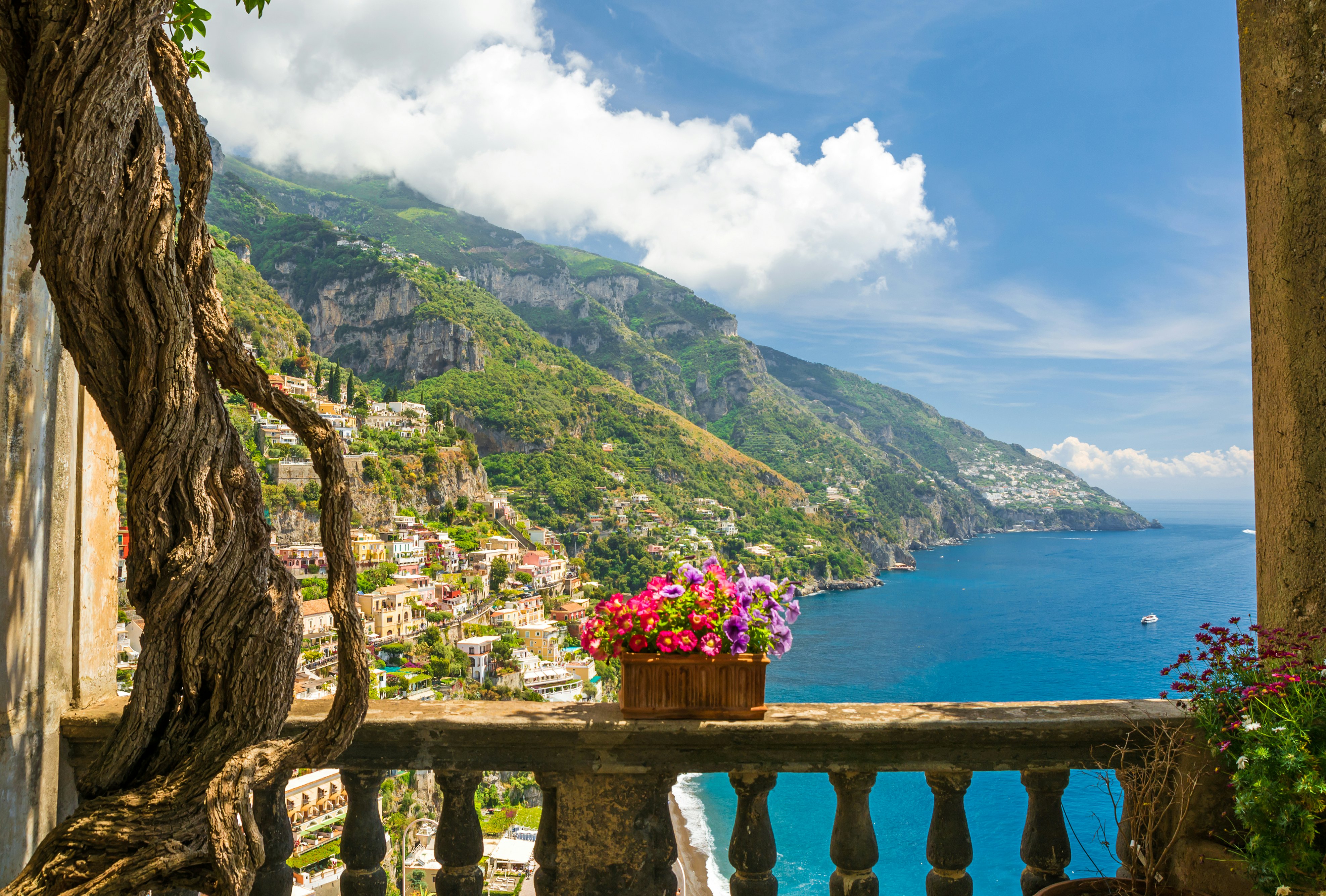
6. Climb the clifftop streets of Positano
The poster child of the Amalfi Coast, insanely gorgeous Positano’s views (and glitzy five-star hotels) have sent poets, artists, writers and celebrities into raptures, John Steinbeck, Picasso, Klee, Liz Taylor, Mick Jagger and Taylor Swift among them.
Romantic? You bet. Looks-wise, the town is a knockout, with pastel-painted, flower-draped houses spilling down a cliffside to the brilliant blues of the Tyrrhenian Sea. Hacked into the rock, its maze of steep streets and staircases crack open the kind of views that hoover up Instagram likes. Bring flat shoes for stiff climbs.
Local tip: Lemons – Positano is famous for them, especially when they add zing to local limoncello and marmalades. Some of the best are sold at Valenti.

7. Escape to Parco Nazionale del Cilento, Vallo di Diano e Alburni
Wave the crowds further north arrivederci and tiptoe quietly into the wondrously pretty Parco Nazionale del Cilento, Vallo di Diano e Alburni. A breath of fresh air after the buzz of Naples or the sun-bronzed hordes of the Amalfi Coast, this national park is all about slipping back to nature in woods, flower-freckled meadows, river valleys and ochre-colored hilltop villages where the out-of-tune bells of campaniles toll. All of this is set against the rugged drama of the Alburi range, dubbed the "Dolomites of Southern Italy."
Nature trails take you properly off the beaten track, but don’t expect them to be brilliantly signposted. The exception to the rule is the path to the highest peak, 1742m (5715ft) Monte Alburno. There are two waymarked trails to the summit from the center of Sicignano degli Alburni (allow four hours for either). The park is also honeycombed with caves, including the otherworldly and unmissable Grotte di Castelcivita. Inhabited 42,000 years ago, these fantasy grottoes are a forest of stalagmites and stalactites.
Planning tip: Come for the springtime eruption of wildflowers, when the park is a fragrant, vibrantly colored mass of narcissi, wild orchids, tulips and poppies.

8. Hike the Sentiero degli Dei
Lace up boots to hook onto the Amalfi Coast’s Sentiero degli Dei (Path of the Gods) for a heavenly feast of southern Italian landscapes, with swoon-worthy views of the rugged, densely wooded Lattari mountains sheering down to the inky-blue Mediterranean, candy-colored villages staggering down hillsides and distant glimpses of Capri. You can nail it in half a day, but with scenery like this, why rush? Pack a picnic and grab a map of the walk from local tourist offices.
Following an elevated, often rocky mule trail linking Agerola (Bomerano) to Nocelle, before tripping down 1700 stone steps to postcard-perfect Positano. The path unzips some of the area's least-developed countryside with minimal effort and is immediately spectacular. You'll traipse past terraced hillsides, lemon orchards and fragrant macchia (scrub) of rosemary and holm oak. A flight of 1500 steps trips gleefully down to Arienzo, where you can pause for a cooling dip, seafood lunch and cocktail at the beach club. The sunsets here are something else.
Planning tip: An easy to moderate hike, the 8km (5-mile) trail takes three to five hours to complete. Get an early start and dodge the worst of the crowds and heat by trekking it in the shoulder seasons (March to mid-June and September to October).
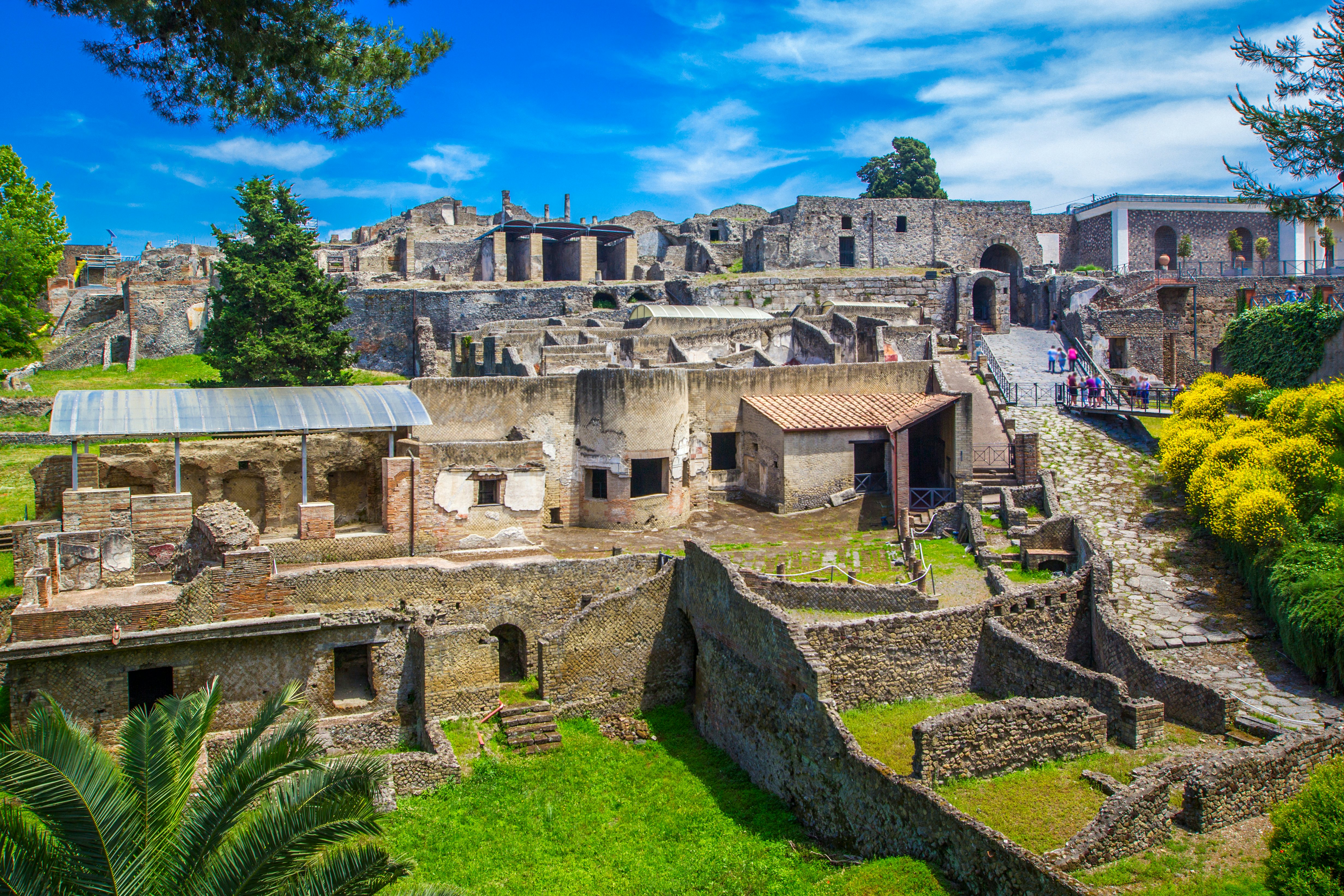
9. Time travel through Pompeii
As the first morning lights up the ruins of Pompeii, you might be moved to tears, or at least wide-eyed wonder. In the shadow of Mt Vesuvius – the volcano that destroyed this once thriving Roman town when it spectacularly erupted back in 79 CE – this vast archaeological site touches deep. Buried under layers of molten lava, ash and lapilli (burning fragments of pumice stone), the ruined city is so remarkably well preserved you can still see the grooves from chariot wheels in the uneven cobbled lanes and vividly picture how life must have been roaming around its marketplaces, bathhouses, temples, frescoed villas, and amphitheaters where gladiators did bloody battle. There’s even a brothel festooned with erotic art.
Part of the beauty of Pompeii is exploring it with no fixed plan, but you won’t want to miss showstoppers like the restored, 90-room Villa dei Misteri, with its Dionysiac frieze depicting a bride-to-be into the cult of Dionysus, and the Terme Stabiane bathing complex, with its stuccoed vault adorned with putti (winged cherubs) and nymphs.
Planning tip: Arrive as Pompeii opens to sneak in before most visitors arrive. Sidestep the biggest crowds by coming during the low season (November to March).

10. Go for a backstreet tour of Naples
Hot, rough around the edges and fizzing with energy, Naples’ true charisma only becomes apparent when you stray beyond big-hitters like the Gallerie d'Italia and its Caravaggio masterpieces. To really feel the city’s pulse, dive into the backstreets, strung with drying laundry, filled with spluttering vespas and alive with neighborly banter, stopping for an espresso on a cafe terrace, a bite of pizza on the hoof or an aperitivo (pre-dinner drink) as the sun plops into the sea.
There are lots of great tours to get you started. If you’re into your food, try Culinary Backstreets, offering a five-hour, button-busting spin of the centro storico (historic center) and beyond, ticking off everything from market to pizzeria, patisserie (for shell-shaped, cream-filled sfogliatella pastries) and baccaleria (for salt cod). If art and culture rock your boat more than food, look up Napoli Paint Stories for street-art tours and Looking for Lila for an eye-opening romp through the city’s lesser-known streets and hidden courtyards.

11. Fall for the beauty of the Sorrento Peninsula
All of Campania is lovely, but the Sorrento Peninsula is the dream, taking its name from the sirens, mythical sea-nymphs who lured sailors to their death with the sweetest of songs. The landscapes are equally fantastical: hairpin roads whip along sheer cliff edges to olive and lemon groves, villages in a fresco painter’s palette of pastels cling to sheer rock walls, and life moves to a relaxed beat in tiny fishing ports.
Once a stop on the 19th-century Grand Tour, Sorrento itself is crazily romantic for a coffee on the piazza or a passeggiata (stroll) in the gold-pinks of sunset. Lord Byron, Keats, Goethe and Dickens found plenty of poetic inspiration here. But it’s the peninsula’s rugged, cove-indented south that will really grab you, with turquoise bays like Baia di Leranto, where you can swim, snorkel and kayak, and Punta Campanella at the very tip, with sublime views out to Capri. Here you can walk trails through the fragrant macchia or dive into electric-blue waters to explore ancient ruins and underwater grottoes.
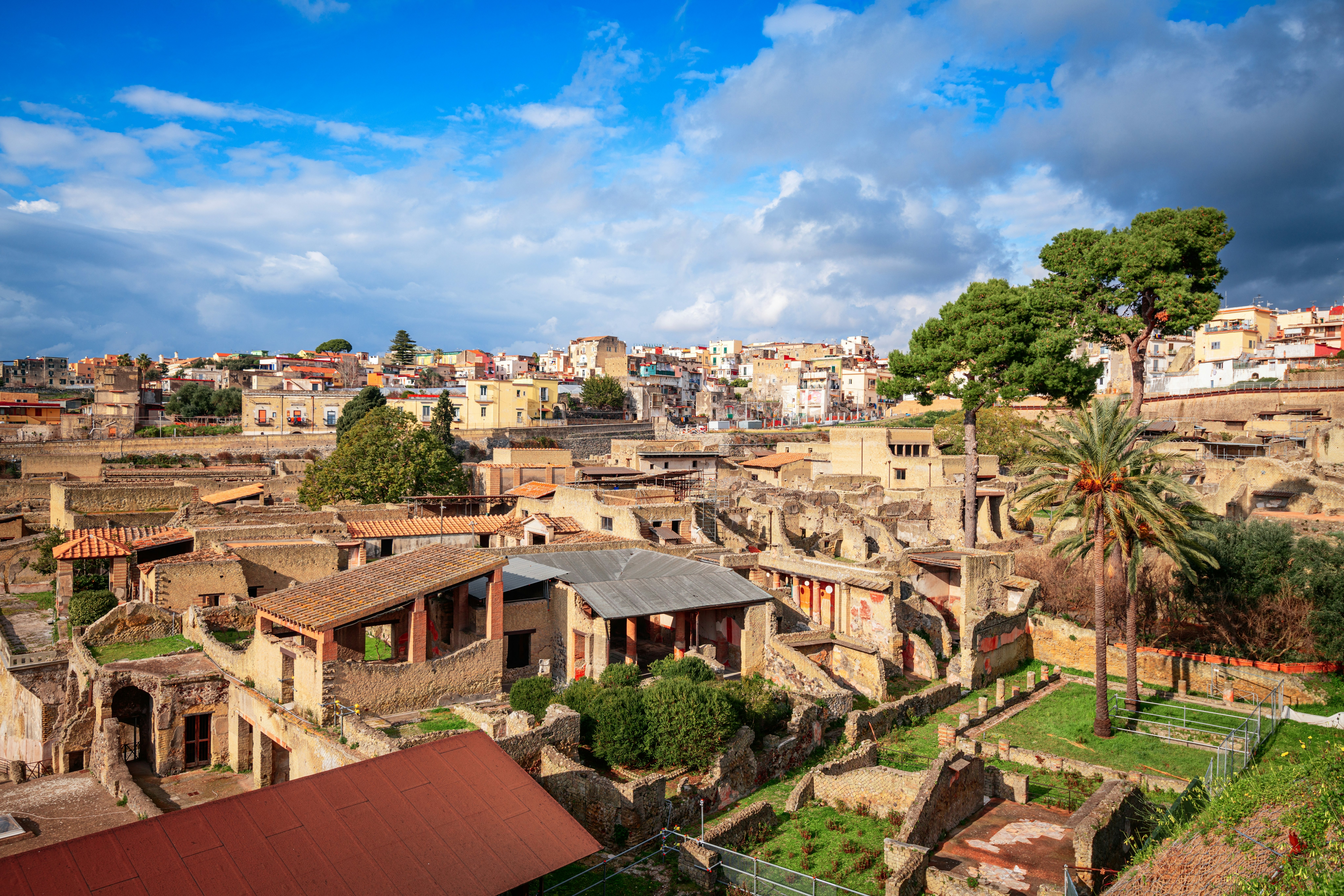
12. Roam the ruins of Herculaneum
Just a quick hop south of Naples, Herculaneum is a spellbinding archaeological site that suffered a similar fate to that of its more-hyped sister, Pompeii, namely being buried by under a 16-m-thick (52ft) layer of molten lava, gas, ash and mud when Mt Vesuvius erupted big time in 79 CE. The pyroclastic flow fossilized the Roman fishing town of 4000 inhabitants, which means the ruins you see today are extraordinarily intact, from mosaics, clothing and furniture to terror-stricken skeletons.
A couple of hours here wings you back to Roman times and gives you a proper glimpse of how life would have been, as you zoom in on highlights like the Casa di Nettuno e Anfitrite, where a lavish mosaic-tiled nymphaeum (fountain and bath as a shrine to the water nymph) depicts the sea god and his bride, the Terme Maschili bathhouse, complete with a shelf for storing sandals and togas, and the Casa del Bel Cortile (House of the Beautiful Courtyard), sheltering three of the 300 skeletons, which were unearthed in 1980, almost two millennia after the eruption.
Planning tip: For more insight, jump the lines and join a two-hour guided tour with an archaeologist.














